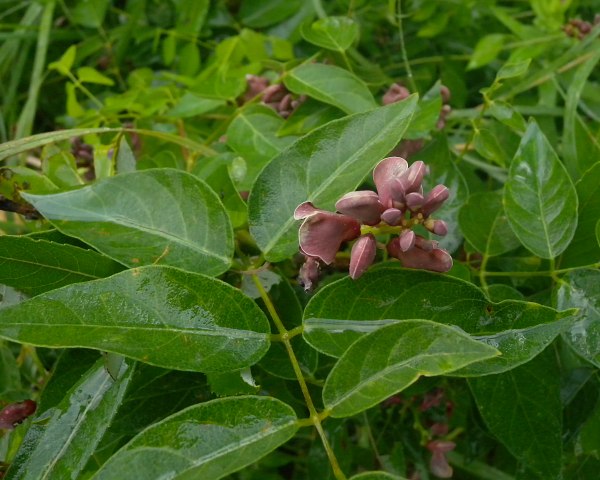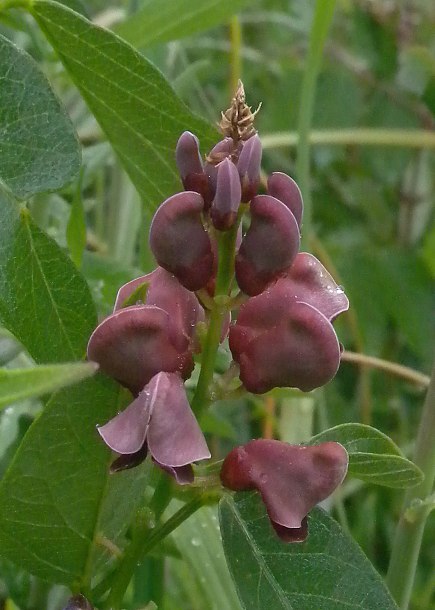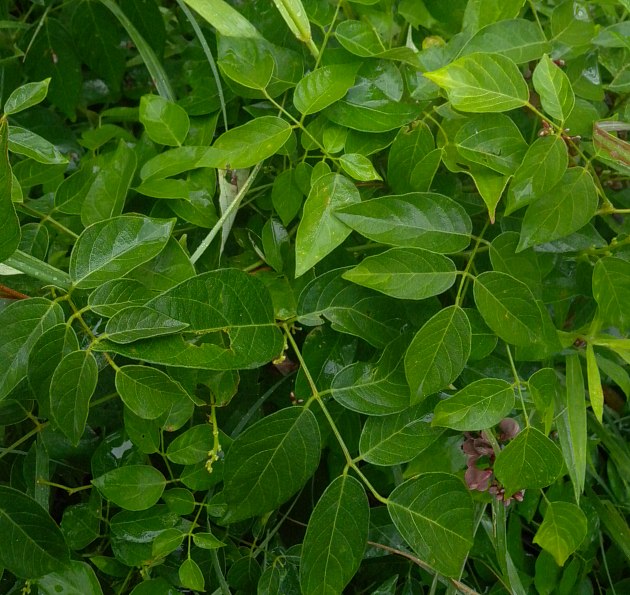
From the axils of the compound leaves, there occasionally develops racemes of flowers that are 2–6" (5–15 cm.) in length; the basal stalks of these racemes are up to 3" long, light green, terete, and hairless to minutely hairy. Flowers are are moderately to densely distributed along these racemes. Each flower has 5 petals forming an ascending standard with an upper keel, a pair of lower lateral wings, and a lower keel that curls upward. These petals are light to moderate maroon (brownish red to brownish purple) toward the front of the flower; toward the back of the flower, they are either a similar shade of maroon or somewhat whitened. The ascending standard functions as a hood over the other floral parts; it has an orbicular shape, but with a sharp keel along its upper side. The standard has either a short, upright, and thickened appendage at the outer tip of its keel, or such an appendage is lacking. Near the throat of the flower, the standard has 2 bands of diagonal black stripes on its inner side. The lower-lateral wings extend forward a shorter distance than the standard above; they are oblanceolate to obovate in shape. The lower keel (consisting of two folded petals) is shaped like an upward scythe with a whitish outer edge.

The short-tubular calyx at the base of the flower is light green or light to medium maroon; it is glabrous to finely short-pubescent. Along the outer rim of the calyx, are 5 shallow and irregular lobes or teeth. The floral rachis (central stalk of the raceme) is light green, terete, hairless to finely short-pubescent, and bumpy from small tubercles; these tubercles are extra-floral nectaries that secret droplets of nectar shortly after the flowers and their pedicels become detached from the floral rachis. The very short pedicels of the flowers are light green, terete, and glabrous to finely short-pubescent. The blooming period occurs from mid-summer to early autumn, lasting about 2 months for a colony of vines. Afterwards, fertile flowers are replaced by slender cylindrical seedpods about 2-4" (5–10 cm.) long and 0.2" (5 mm.) across that are light green to yellowish green; these seedpods are often slightly curved (up or down) and slightly compressed along their sides. However, some vines are sterile and they don't produce seedpods after the flowers bloom.
 The seedpods each contain
several seeds;
eventually they divide into 2 parts, ejecting their
seeds. Fresh individual seeds are medium maroon with an inflated
reniform shape; dried seeds become dark brown and more chunky. The root
system is fibrous, long-rhizomatous, and tuberous; the tubers are
arranged at intervals along the rhizomes like knotted ropes. Individual
tubers are ½–3" long and ovoid to globoid in shape; they have brown
exteriors and white interiors. This vine reproduces primarily (or even
entirely) by its tuberous rhizomes, forming clonal vines. A vine with
fertile flowers and seedpods can also reproduce by reseeding itself.
The seedpods each contain
several seeds;
eventually they divide into 2 parts, ejecting their
seeds. Fresh individual seeds are medium maroon with an inflated
reniform shape; dried seeds become dark brown and more chunky. The root
system is fibrous, long-rhizomatous, and tuberous; the tubers are
arranged at intervals along the rhizomes like knotted ropes. Individual
tubers are ½–3" long and ovoid to globoid in shape; they have brown
exteriors and white interiors. This vine reproduces primarily (or even
entirely) by its tuberous rhizomes, forming clonal vines. A vine with
fertile flowers and seedpods can also reproduce by reseeding itself.Cultivation: The preference is light shade to full sun, moist conditions, and loamy, gravelly, or sandy soil containing some organic matter. The root system of this vine fixes atmospheric nitrogen in the soil. This vine may fail to bloom during some years, and when it blooms the flowers often fail to produce seedpods. It can be easily propagated by digging up the tubers of the root system and planting them elsewhere.
Range & Habitat: The native Groundnut (Apios americana) is occasional throughout Illinois. Compared to the past, populations of this vine may have declined because of habitat destruction. It is widely distributed in the eastern half of the United States and southeastern Canada. Habitats include moist to mesic woodlands, typical thickets and sandy thickets, typical sloughs and sandy sloughs, moist prairies and moist meadows, typical seeps and gravelly seeps, banks of streams, and edges of fens. This vine is found in average to high quality natural areas.
Faunal Associations: The flowers are visited primarily by bees for nectar and, to a lesser extent, pollen. This includes honeybees, bumblebees, leaf-cutting bees (Megachile spp.), and Halictid bees. Leaf-cutting bees are considered the most important cross-pollinators of the flowers. Yellow jackets (Vespula spp.) have also been reported to visit the flowers to a lesser extent (see Robertson, 1929; Bruneau & Anderson, 1994). A claim has been made, on the basis of the structure and coloration of the flowers, that flies are likely to be the primary pollinators of the flowers (Westercamp & Paul, 1993), but this hypothesis has not been substantiated by empirical observation. Several species of ants have been observed to visit the tuberculous extra-floral nectaries on the central stalks of the floral racemes (Harvey, 2009).

Other insects feed on the leaves of Groundnut (Apios americana). This includes the leaf-mining larvae of Pachyschelus schwarzi (a metallic wood-boring beetle), leaf-mining larvae of Cerotoma trifurcata (Bean Leaf Beetle) and Odontota scapularis (Orange-shouldered Leafminer Beetle), and leaf-eating caterpillars of Epargyreus clarus (Silver-spotted Skipper) and Thorybes bathyllus (Southern Cloudywing); see MacRae (1991), Clark et al. (2004), and Barnes (1999). Among vertebrate animals, White-tailed Deer have been observed to feed on the foliage of this vine, and it has been considered a possible source of forage for goats (Morales et al., 2009). Both the seeds and tubers are edible to humans, and they were considered an excellent source of food by both early pioneers and Amerindians. Compared to other commonly eaten tubers and root vegetables, the tubers of Groundnut are unusually high in protein. This vine also provides excellent protective cover for many small to medium-sized mammals, birds, and other fauna.
Photographic Location: A moist thicket at Bluff Spring Fen Nature Preserve in Cook County, Illinois.

Comments: Groundnut (Apios americana) produces attractive, if somewhat untidy, foliage and unusually colored flowers. As an additional bonus, both seeds and tubers of this vine are edible to humans. Groundnut can be distinguished from similar herbaceous vines by the presence of alternate compound leaves that usually have 5 leaflets; its flowers are also very distinctive. There are both diploid and triploid Groundnut vines. The diploid vines are fertile and they are capable of producing seedpods, while triploid vines are infertile and they never produce seedpods. The infertile triploid vines are supposed to be more common toward the northern extent of Groundnut's range. Morphologically, these two groups of vines cannot be readily distinguished. One vine in Illinois, Amphicarpaea bracteata (Hog Peanut), could be confused with Groundnut, but the Hog peanut has compound leaves with only 3 leaflets (never 5 or 7) and its flowers are light pink and more cylindrical in shape. There is another species, Price's Groundnut (Apios priceana), that shares the same genus as the Groundnut. The uncommon Price's Groundnut occurs primarily to the south of Illinois, although it has been found in a single county in southern Illinois, where it is state-listed as endangered. Price's Groundnut can be distinguished by the pink or whitish pink coloration of its flowers, and by the long, upright, and thickened appendage that is located in front of the keel on the banner of its flowers. The root system of Price's Groundnut is said to produce larger tubers that are solitary, while the more common Groundnut produces smaller tubers that are arranged along individual rhizomes like a knotted rope. Other common names of Apios americana are American Groundnut and American Potato Bean.